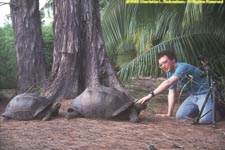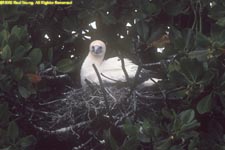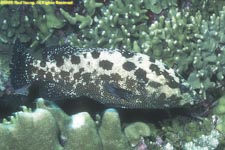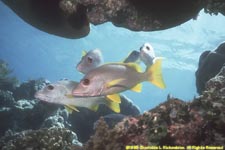


















A joint British and American plan to build a military base and broadcasting station for the British Indian Ocean Territories (Aldabra, Desroches, Farquhar, and Diego Garcia) on Aldabra was finally thwarted in 1967, partially due to the influence of Jacques Cousteau (the base was built on Diego Garcia instead), and Aldabra was declared a Unesco World Heritage Site. It was opened to tourism in December, 1991.
 Bluefin trevally, Caranx melampygus
Bluefin trevally, Caranx melampygus
 Black-backed butterflyfish, Chaetodon melannotus
Black-backed butterflyfish, Chaetodon melannotus
 Barred sweetlips, Plectorhinchus plagiodesmus
Barred sweetlips, Plectorhinchus plagiodesmus
 Brown-marbled grouper, Epinephelus fuscoguttatus
Brown-marbled grouper, Epinephelus fuscoguttatus

 Marbled grouper, Epinephelus polyphekadion
Marbled grouper, Epinephelus polyphekadion
 Malabar grouper, Epinephelus malabarius, with common cleaner wrasse, Labroides dimidiatus
Malabar grouper, Epinephelus malabarius, with common cleaner wrasse, Labroides dimidiatus
 Eyestripe (Dussumier's, orante) Surgeonfish, Acanthurus dussumieri)
Eyestripe (Dussumier's, orante) Surgeonfish, Acanthurus dussumieri)
 Indian doublebar goatfish, Parupeneus trifasciatus
Indian doublebar goatfish, Parupeneus trifasciatus
 One-spot snapper, Lutjanus monostigma
One-spot snapper, Lutjanus monostigma
 Jewel fairy basslet, Pseudanthias squamipinnis
Jewel fairy basslet, Pseudanthias squamipinnis
 Marcia's fairy basslet, Pseudanthias marcia
Marcia's fairy basslet, Pseudanthias marcia
 Flathead scorpionfish, Scorpaenopsis oxycephalus
Flathead scorpionfish, Scorpaenopsis oxycephalus
 Blacktip grouper, Epinephelus fasciatus
Blacktip grouper, Epinephelus fasciatus
 Forster's hawkfish, Paracirrhites forsteri
Forster's hawkfish, Paracirrhites forsteri
 Blotched hawkfish, Cirrhitichthys aprinus
Blotched hawkfish, Cirrhitichthys aprinus
 juvenile Diana's hogfish, Bodianus diana
juvenile Diana's hogfish, Bodianus diana
 Common cleaner wrasse, Labroides dimidiatus, on giant moray, Gymnothorax javanicus
Common cleaner wrasse, Labroides dimidiatus, on giant moray, Gymnothorax javanicus
 Dark-banded fusilier, Pterocaesio tile
Dark-banded fusilier, Pterocaesio tile
 juvenile humpnose bigeye bream, Monotaxis grandoculis
juvenile humpnose bigeye bream, Monotaxis grandoculis
 Plain (goldbelly) Cardinalfish, Ostorhinchus apogonoides
Plain (goldbelly) Cardinalfish, Ostorhinchus apogonoides
 Blackbar Damselfish, Plectroglyphidodon dickii
Blackbar Damselfish, Plectroglyphidodon dickii
 Blackspotted Puffer, Arothron nigropunctatus
Blackspotted Puffer, Arothron nigropunctatus
 Scythe triggerfish, Sufflamen cf bursa
Scythe triggerfish, Sufflamen cf bursa
 Yellow sweepers, Parapriacanthus ransonneti
Yellow sweepers, Parapriacanthus ransonneti
 Elegant phyllidia, Phyllidia elegans
Elegant phyllidia, Phyllidia elegans
 Pyjama slug, Chromodoris quadricolor
Pyjama slug, Chromodoris quadricolor
 Varicose wart slug, Phyllidia varicosa
Varicose wart slug, Phyllidia varicosa
 Meyer's butterflyfish, Chaetodon meyersi
Meyer's butterflyfish, Chaetodon meyersi
 Phantom bannerfish, Heniochus pleuritaenia
Phantom bannerfish, Heniochus pleuritaenia
 Northern Indian anemonefish, Amphiprion sebae
Northern Indian anemonefish, Amphiprion sebae
 Skunk anemonefish, Amphiprion akallopsis
Skunk anemonefish, Amphiprion akallopsis
 Painted spiny lobster, Panulirus versicolor
Painted spiny lobster, Panulirus versicolor
 Comoros spider conch, Lambis lambis
Comoros spider conch, Lambis lambis
©2009, 2014, 2016, 2017, 2018, 2019, 2024, 2025 Mermaid Underwater Photographic. All Rights Reserved.
Contact us at mermaid@underwater.org.
Last modified 12 December 2025